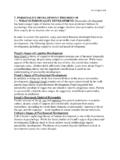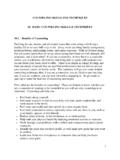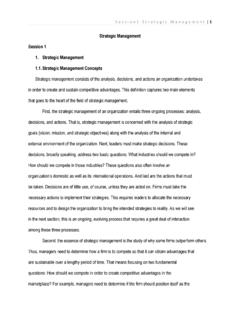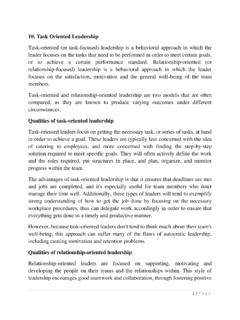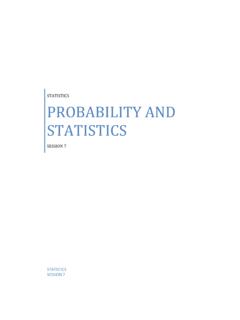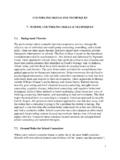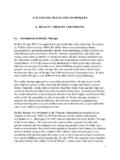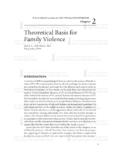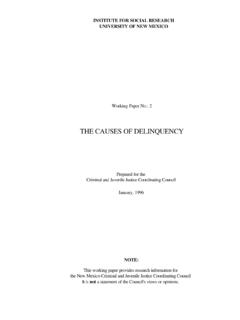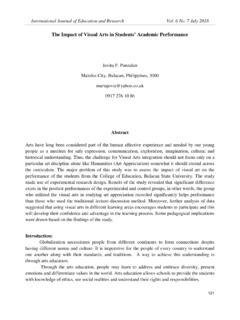Transcription of 4. PSYCHODYNAMICS 4.1 PSYCHODYNAMICS: …
1 SEC 4 Page 1 of 7 4. PSYCHODYNAMICS PSYCHODYNAMICS : PSYCHODYNAMICS , also known as dynamic psychology, in its broadest sense, is an approach to psychology that emphasizes systematic study of the psychological forces that underlie human behavior, feelings, and emotions and how they might relate to early experience. It is especially interested in the dynamic relations between conscious motivation unconscious motivation . The term PSYCHODYNAMICS is also used by some to refer specifically to the psychoanalytical approach developed by Sigmund Freud (1856 1939) and his followers. Freud was inspired by the theory of thermodynamics and used the term PSYCHODYNAMICS to describe the processes of the mind as flows of psychological energy (libido) in an organically complex brain. In the treatment of psychological distress, psychodynamic psychotherapy tends to be a less intensive, once- or twice-weekly modality than the classical Freudian psychoanalysis treatment of 3-5 sessions per week.
2 Psychodynamic therapies depend upon a theory of inner conflict, wherein repressed behaviors and emotions surface into the patient s consciousness; generally, one conflict is subconscious. In general, PSYCHODYNAMICS is the study of the interrelationship of various parts of the mind, personality, or psyche as they relate to mental, emotional, or motivational forces especially at the unconscious level. The mental forces involved in PSYCHODYNAMICS are often divided into two parts: (a) the interaction of the emotional and motivational forces that affect behavior and mental states, especially on a subconscious level; (b) inner forces affecting behavior: the study of the emotional and motivational forces that affect behavior and states of mind. Freud proposed that psychological energy was constant (hence, emotional changes consisted only in displacements) and that it tended to rest (point attractor) through discharge (catharsis).
3 In mate selection psychology, PSYCHODYNAMICS is defined as the study of the forces, motives, and energy generated by the deepest of human needs. In general, PSYCHODYNAMICS studies the transformations and exchanges of "psychic energy" within the personality. A focus in PSYCHODYNAMICS is the connection between the energetics of emotional states in the id, ego, and superego as they relate to early childhood developments and processes. At the heart of psychological processes, according to Freud, is the ego, which he envisions as battling with three forces: the id, the super-ego, and the outside world. The id is the unconscious reservoir of libido, the psychic energy that fuels instincts and psychic SEC 4 Page 2 of 7 processes. The ego serves as the general manager of personality, making decisions regarding the pleasures that will be pursued at the id's demand, the person's safety requirements, and the moral dictates of the superego that will be followed.
4 The superego refers to the repository of an individual's moral values, divided into the conscience - the internalization of a society's rules and regulations - and the ego-ideal - the internalization of one's goals. Hence, the basic psychodynamic model focuses on the dynamic interactions between the id, ego, and superego. PSYCHODYNAMICS , subsequently, attempts to explain or interpret behavior or mental states in terms of innate emotional forces or processes. Psychodynamic Approach If you know very little about psychology, and you have heard of just one psychologist, the chances are that this is Sigmund Freud, the founder of the psychodynamic approach to psychology, orpsychoanalysis. If Freud represents your layperson's idea of psychology then you probably have an image of a patient lying on a couch talking about their deepest and darkest secrets.
5 In deliberate contrast to behavioral psychology, psychodynamic psychology ignores the trappings of science and instead focuses on trying to get 'inside the head' of individuals in order to make sense of their relationships, experiences and how they see the world. The psychodynamic approach includes all the theories in psychology that see human functioning based upon the interaction of drives and forces within the person, particularly unconscious, and between the different structures of the personality. Freud s psychoanalysis was the original psychodynamic theory , but the psychodynamic approach as a whole includes all theories that were based on his ideas, Jung (1964), Adler (1927) and Erikson (1950). The words psychodynamic and psychoanalytic are often confused. Remember that Freud s theories were psychoanalytic , whereas the term psychodynamic refers to both his theories and those of his followers.
6 Freud s psychoanalysis is both a theory and a therapy. Sigmund Freud (writing between the 1890s and the 1930s) developed a collection of theories which have formed the basis of the psychodynamic approach to SEC 4 Page 3 of 7 psychology. His theories are clinically derived - based on what his patients told him during therapy. The psychodynamic therapist would usually be treating the patient for depression or anxiety related disorders. FREUD: ACTS ABOUT PERSONALITY: Sigmund Freud s psychoanalytic theory : Sigmund Freud s psychoanalytic theory is an example of psychodynamic approach to the study of human behavior. With this approach, it is believed that the unconscious psychological conflicts control human behavior. Sigmund Freud, the founder of psychoanalysis, built the psychoanalytic concepts almost entirely relying on his extensive clinical observations of patients with neuroses, as well as on psychoanalysis.
7 Freud distinguished three levels of consciousness the conscious, the subconscious and theunconscious to describe the degree of accessibility of the mental processes of awareness. The most significant psychic events take place in the unconscious (which by its nature is instinctive and detached from reality.) In Freud s theory , human personality consists of three structural components: the ID, EGO and SUPEREGO. ID, which is the instinctive core of the personality, is a primitive, impulsive and subject to the principle of pleasure. ID uses reflex reactions and primary representation in order to obtain immediate gratification of instinctual impulses. EGO is the rational part of the personality and the principle of reality. Its task is to develop an individual action plan to meet the requirements of the ID within the constraints of the social world and the consciousness of the individual.
8 This problem, the EGO resolves with secondary reporting processes. SUPEREGO, the latest in the emerging process of personal development, it is the moral side. The superego consists of two structures the conscience and ego ideal. Freud s theory of motivation Freud s theory of motivation is based on the concept of instinct, defined as an innate state of excitement, which is looking for relaxation. In psychoanalytic theory distinguishes two categories of instinct: the instinct of life (Eros) and the death instinct (Thanatos). Instinct has four basic parameters: the source, target, object and stimulus. This Freud s explanation of the stages of psychosexual development is based on the premise that sexuality is given at birth and develops further, covering a number of biologically specific erogenous zones until reaching maturity.
9 SEC 4 Page 4 of 7 Psychosexual development After Freud personality development goes through the following four stages: oral, anal, phallic and genital. The latency period is a stage of psychosexual development. Freud thought that in the process of psychosexual development the unresolved conflicts lead to fixation and formation of certain types of character. For example, adults with a fixation on anal retention stage become inflexible, boring and forcibly accurate. Defense mechanisms Freud distinguished three types of anxiety: a realistic, neurotic and emotional. He believed that anxiety plays the role of warning signal ego about the impending danger from instinctual impulses. In response, the ego uses a number of safeguards, including the repression, projection, displacement, rationalization, reaction formation, regression, sublimation, and denial.
10 Defense mechanisms are unconscious and distort the perception of reality by the individual. Freud s theory is based on certain assumptions about the nature of man. Sigmund Freud s psychoanalytic theory Today Many psychoanalytic concepts still need rigorous empirical testing. Freud argued the empirical validity of his theory on the basis of clinical observations during therapy, and he also objected the experimental research in laboratory. However, there were some attempts to establish the validity of certain concepts of psychoanalysis. The most typical research was focused on an experimental evaluation of displacement and subliminal psychodynamic activation of unconscious conflict, as well as their impact on the pathological behavior. These studies have provided empirical support for certain key psychoanalytic hypotheses.
